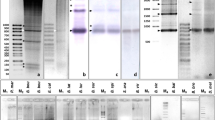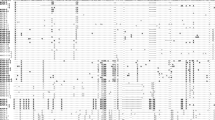Abstract
The satellite II DNA of Drosophila nasutoides is a highly diverged repetitive DNA, showing about 17% base changes between repeat units (Cordeiro-Stone and Lee, 1976). This DNA is cleaved by four different restriction enzymes to produce multimeric fragmentation patterns, indicating that their restriction sites are regularly arranged. Moreover, all four enzymes produce identical fragment lengths, the size of a monomer being 96 base pairs. Such multimeric patterns are expected for a diverged repetitive DNA, since many restriction sequences could have undergone changes during sequence divergence. Further restriction analyses of this DNA by double digestions and cloning reveal that there are three different sequences in satellite II DNA with respect to the presence and the arrangement of various restriction sites (Fig. 7). As an example, one sequence contains many EcoRI sites and fewer Hinfl sites (20% of EcoRI sites), which are arranged regularly. These observations suggest that satellite II DNA of D. nasutoides might have evolved through different modes of sequence divergence.
Similar content being viewed by others
References
Beauchamp, R.S., Mitchell, A.R., Buckland, R.A., Bostock, C.J.: Specific arrangements of human satellite III DNA sequences in human chromosomes. Chromosoma (Berl.) 71, 153–166 (1979)
Biro, P.A., Carr-Brown, A., Southern, E.M., Walker, P.M.B.: Partial sequence analysis of mouse satellite DNA: Evidence for short range periodicities. J. molec. Biol. 94, 71–86 (1975)
Brutlag, D., Carlson, M., Fry, K., Hsieh, T.S.: DNA sequence organization in Drosophila heterochromatin. Cold. Spr. Harb. Symp. quant. Biol. 42, 1137–1146 (1977)
Cohen, S.N., Chang, A.C.Y., Hsu, L.: Nonchromosomal antibiotic resistance in bacteria: Genetic transformation of E. coli by R-factor DNA. Proc. nat. Acad. Sci. (Wash.) 69, 2110–2114 (1972)
Cordeiro-Stone, M., Lee, C.S.: Studies on the satellite DNAs of Drosophila nasutoides: Their buoyant densities, melting temperatures, reassociation rates and localization in polytene chromosomes. J. molec. Biol. 104, 1–24 (1976)
Gall, J.G., Cohen, E.H., Atherton, D.D.: The satellite DNAs of Drosophila virilis. Cold Spr. Harb. Symp. quant. Biol. 38, 417–421 (1973)
Hörz, W., Zachau, H.G.: Characterization of distinct segments in mouse satellite DNA by restriction endonucleases. Europ J. Biochem. 73, 383–392 (1977)
Mandel, M., Higa, A.: Calcium-dependent bacteriophage DNA infection. J. molec. Biol. 53, 159–162 (1970)
Manteuil, S., Hamer, D.H., Thomas, C.A.: Regular arrangement of restriction sites in Drosophila DNA. Cell 5, 413–422 (1975)
Manuelidis, L.: Complex and simple sequences in human repeated DNAs. Chromosoma (Berl.) 66, 1–21 (1978)
Peacock, W.J., Brutlag, D., Goldring, E., Appels, R., Hinton, C.W., Lindsley, D.L.: The organization of highly repeated DNA sequences in Drosophila melanogaster chromosomes. Cold. Spr. Harb. Symp. quant. Biol. 38, 405–416 (1973)
Philippsen, P., Lee, C.S., Davis, R.W.: Cloning of satellite DNA sequences with the λ vector λgt-araB. In: Molecular approaches to eukaryotic genetic systems (G. Wilcox and J. Abelson, eds.), pp. 63–72. ICN-UCLA Symp. vol. 8. New York: Academic Press 1977
Smith, G.P.: Evolution of repeated DNA sequences by unequal crossover. Science 191, 528–535 (1976)
Southern, E.M.: Long range periodicities in mouse satellite DNA. J. molec. Biol. 94, 51–69 (1975)
Spofford, J.B.: Position-effect variegation in Drosophila. In: The genetics and biology of Drosophila, vol. 1C (M. Ashburner and E. Novitski, eds.), pp. 955–1018. New York: Academic Press 1976
Sugino, A., Goodman, H.M., Heynecker, H.L., Shine, J., Boyer, H.W., Cozzarelli, N.R.: Interaction of bacteriophage T4 RNA and DNA ligases in joining of duplex DNA at base-paired ends. J. biol. Chem. 252, 3987–3994 (1977)
Sutcliffe, J.G.: pBR322 restriction map derived from the DNA sequence: accurate DNA size markers up to 4361 nucleotide pairs long. Nucleic Acids Res. 5, 2721–2728 (1978a)
Sutcliffe, J.G.: Complete nucleotide sequence of the Escherichia coli plasmid pBR322. Cold Spr. Harb. Symp. quant. Biol. 43, 77–90 (1978b)
Walker, P.M.B.: Repetitive DNA in higher organisms. Prog. Biophys. molec. Biol. 23, 145–190 (1971)
Author information
Authors and Affiliations
Rights and permissions
About this article
Cite this article
Lee, C.S. Restriction enzyme analysis of a highly diverged satellite DNA from Drosophila nasutoides . Chromosoma 83, 367–379 (1981). https://doi.org/10.1007/BF00327359
Received:
Issue Date:
DOI: https://doi.org/10.1007/BF00327359




